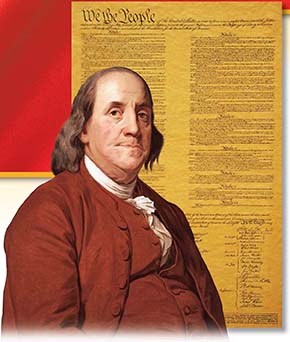SECTION 3: Ratifying the Constitution

◄ Benjamin Franklin and the U.S. Constitution
WITNESS HISTORY  AUDIO
AUDIO
A Hopeful Future
After the hard work was completed at the Constitutional Convention, the delegates set out to win approval of the document they had created from the states. With amendments, that document—the United States Constitution—has now endured for more than 200 years. At the time, however, the system of government established by the document was in no way secure. Benjamin Franklin wryly observed:
“Our Constitution is in actual operation; everything appears to promise that it will last; but in this world nothing is certain but death and taxes.”
—Benjamin Franklin, 1789
Objectives
- Summarize the arguments for and against ratification of the Constitution.
- Describe how the Constitution was ratified.
- Explain the principles of the Constitution.
Terms and People
- ratification
- Federalist
- Antifederalist
- The Federalist
- John Jay
- Bill of Rights
- popular sovereignty
- limited government
- separation of powers
- checks and balances
- electoral college
NoteTaking
Reading Skill: Identify Main Ideas Use a table to record the arguments for and against ratification of the Constitution.
| Arguments For | Arguments Against |
|---|---|
|
|
Why It Matters The delegates to the Constitutional Convention had designed a strong federal government. As you learned, all but three delegates endorsed the new Constitution, despite the fact that many felt it was imperfect. After most of the delegates signed it, the proposed Constitution was printed, circulated, and hotly debated. The question remained whether the states would accept the proposed plan. If they did not, what would become of the new nation? Section Focus Question: How did Americans ratify the Constitution, and what are its basic principles?
The Struggle Over Ratification
By drafting a new Constitution, the delegates had exceeded their mandate. They were only supposed to propose amendments to the Articles of Confederation. Official approval, or ratification, of an entirely new constitution was doomed if all 13 states had to approve it as the Articles required. To improve the odds of ratification, the delegates arbitrarily decided to change the rules. They determined that approval by nine states would suffice. They also took the ratification decision away from the state legislatures, for they would most certainly oppose a new constitution that would deprive them of some power. Instead, the delegates ruled that specially elected conventions would determine a state’s choice for or against the Constitution. Two groups soon emerged in the debate: the Federalists, who favored ratification, and the Antifederalists, who opposed it.




